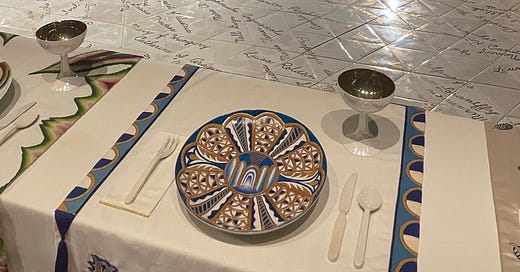Who is invited to your Dinner Party? The guests have changed for me throughout the years. Right now, I think I might invite the fictional character Brian from Company, or the mystical Teresa of Avila, definitely Sacagawea of the Corps of Discovery, and Queen’s frontman, Freddie Mercury. And the one and only, Judy Garland (maybe Liza, too). Georgia O’Keefe and her many lovers (her flowers from Lake George might adorn the table). Essayist Susan Sontag and Rachel Carson of Silent Spring. Maybe fashion designers, Cristobal Balenciaga and Hubert Givenchy. I think I would add activist Larry Kramer, too, but he might hog the conversation (in an annoyingly good way). It is a big dinner party. I would not want anything less. Judy Chicago spent quite a bit of time inviting her guests to dinner - all women. Her monumental piece, The Dinner Party lives at the Brooklyn Museum. Chicago is currently the focus of a retrospective at the de Young Museum in San Francisco. Though, The Dinner Party is not included, I am revisiting it as I prepare to view the new exhibit.
I have visited The Dinner Party multiple times. The first time I was on an art pilgrimage to see my first Keith Haring exhibit at the Brooklyn Museum in 2013. I was already emotionally raw from seeing Keith’s pieces for the first time (little did I know I would be involved in an exhibit of Haring’s work shortly thereafter, a dream come true). It was my first time in New York feeling the energy, the diversity, and the collisions, that of, a mega city. It is right that these women gather here in the corner of Prospect Park in the heart of Brooklyn. I have usually been alone in the gallery that holds the installation and reading about the historical women Chicago highlights and honors in each table setting. In June 2021, I visited it with my dear friend Beth. She was pregnant and we rushed to the museum in between business meetings. I had to show her this piece. I had talked about it for years. Beth would be at my dinner, too. Women scientists are a must have at any dinner party.
When I visit museum with friends, a switch usually turns on and I want them to feel the piece or understand why I connect to the pieces or artist emotionally. I am constantly trying to lower the barrier of entry into an understanding of the artist intent. I know I see things a bit differently. Artist put barriers up on purpose, self-preservation, or creating space in between, or otherwise. Judy makes space for these powerful women to sit together, separately. Each woman has their own setting, their own name stitched lovingly into the table runner. Craft is present. These are royal table settings. The reverence is apparent as you walk in with the dramatic lighting and ceramic center reflecting the names of the women placed in gold. As they should be. Sculptural, historical, lyrical, and mystical. I have never tired of The Dinner Party. I always learn about new women in history that are overlooked, misremembered, or other subversive talent. The making of the actual piece is a bit fraught as there are differing recollections of “collaboration,” services rendered and not paid for, and other narratives of the craftswomen who dedicated their talents to the completion of the work. Nonetheless, the piece stands as a testament to revisiting history, re-crafting a new narrative, and centering women who have pushed our society forward.

From the Brooklyn Museum, “The Dinner Party, an important icon of 1970s feminist art and a milestone in twentieth-century art, is presented as the centerpiece around which the Elizabeth A. Sackler Center for Feminist Art is organized. The Dinner Party comprises a massive ceremonial banquet, arranged on a triangular table with a total of thirty-nine place settings, each commemorating an important woman from history. The settings consist of embroidered runners, gold chalices and utensils, and china-painted porcelain plates with raised central motifs that are based on vulvar and butterfly forms and rendered in styles appropriate to the individual women being honored. The names of another 999 women are inscribed in gold on the white tile floor below the triangular table. This permanent installation is enhanced by rotating Herstory Gallery exhibitions relating to the 1,038 women honored at the table.”

















Share this post